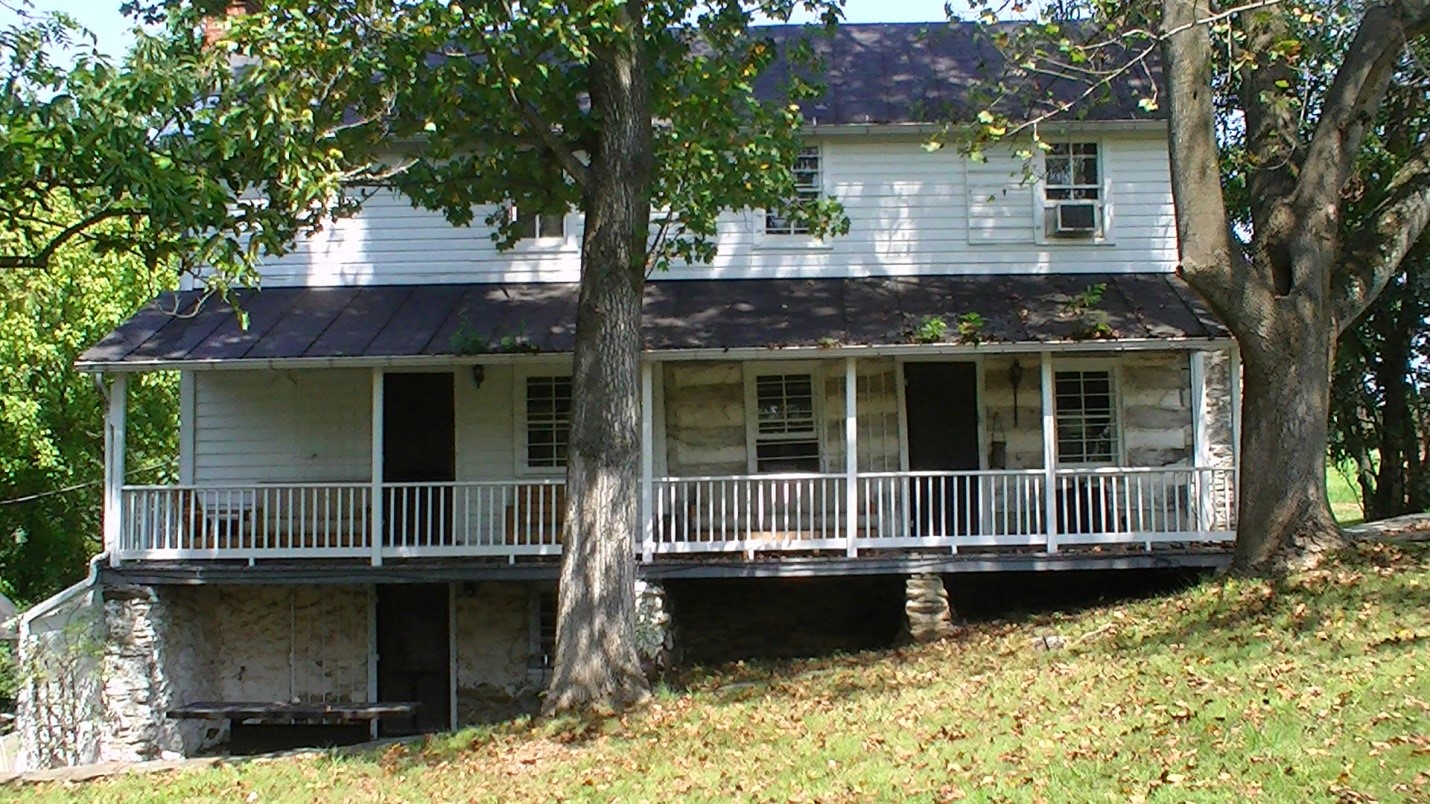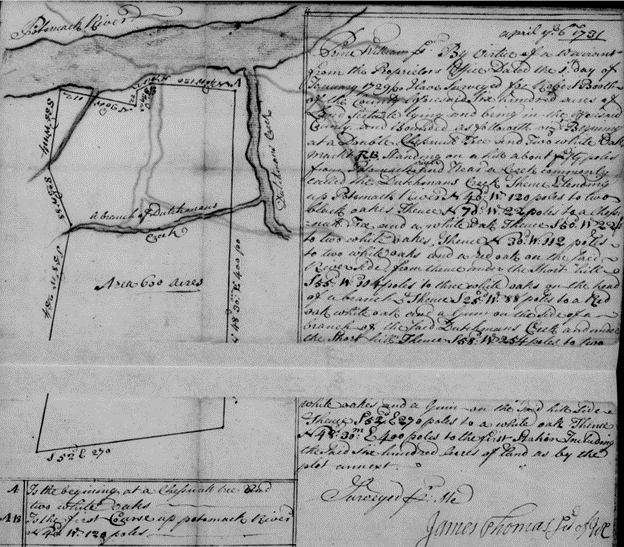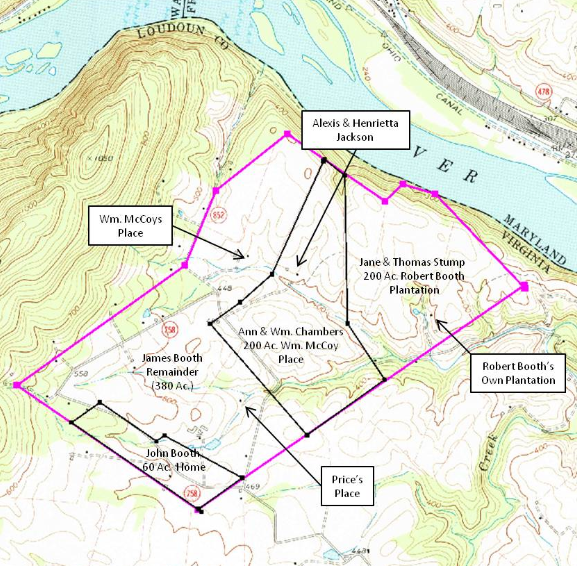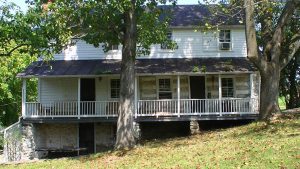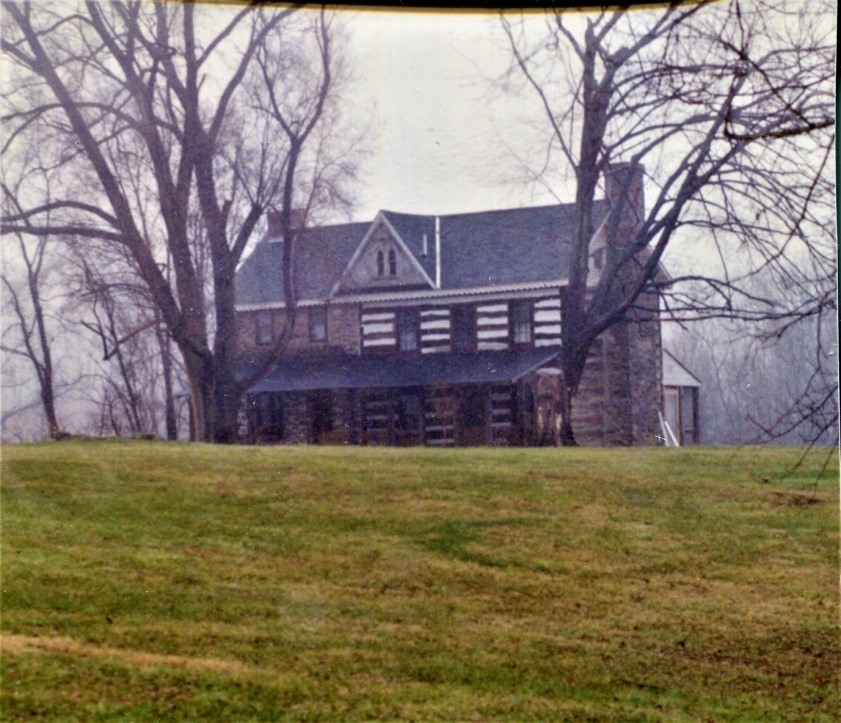(Updated 3/14/21)
By Harold Gladstone
Introduction
Five years before Thomas, 6th Lord Fairfax granted 17,296 acres of land Northwest of Lovettsville to his recently appointed land agent and cousin Colonel William Fairfax[1], Robert Booth was granted 600 acres of land near the Potomack (sic) River, East of the Short Hill on a tributary of the Dutchman’s Creek[2]. With this Land Grant, Robert Booth became the first recorded land owner near what is now Lovettsville, Virginia. Thereafter, until well after the American Revolutionary War, land in this area could only be leased from William Fairfax (and heirs) or be purchased or leased through the Robert Booth Land Grant.
Little is known about the life of Robert Booth. He’s believed to be English, of Anglican faith and probably born sometime before 1700[3]. His parents are unknown, but he may have descended from one of the many Booth families known to have populated the Virginia tidewater and Chesapeake Bay areas of the late 1600’s[4], but no documented connection to those families has been found. He was married, probably circa 1715[5] , to Sarah Filmore in Prince Georges County, Maryland and had four children of record: John, Jane, Ann and James[6]. The Filmore surname can also be found in late 1600 Chesapeake Bay area[7] although no documented connection is known to exist for Sarah either. What enticed Robert to settle West at the time is unknown, but his legacy suggests he lived off the land as a farmer and landlord. He died circa the first of March 1760[8], and outside his land holdings, was not a man of wealth[9], with an estate inventoried at 16£. Although his estate bequests were defined by his will, a number of unforeseen circumstances occurred after his death that had a profound effect on the eventual estate settlement. It wasn’t until some 76 years later that the courts finally resolved the various claims arising from Robert Booth’s Will.
Piscataway Parish Record
The earliest known Robert Booth record is found in the church records for Piscataway Parish[10] , current day St. John’s Episcopal Church, Fort Washington, Maryland. A copy of the marriage and birth records for Robert Booth and Sarah Filmore and their first two children is shown in Figure 1. The entries are believed to be a transcription from earlier records, and the marriage date lost or not recorded.
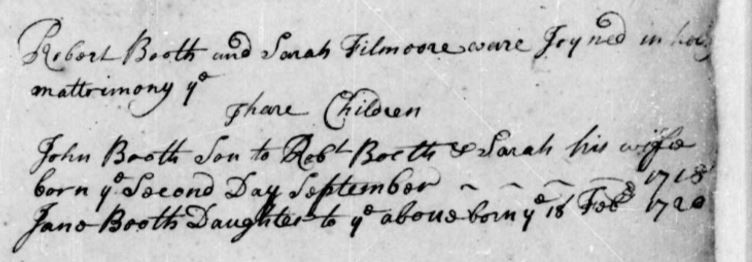
FIGURE 1. ROBERT BOOTH & SARAH FILMORE MARRIAGE AND CHILDREN JOHN & JANE BOOTH BIRTH RECORDS FROM THE PISCATAWAY PARISH 1692-1726 RECORD.
Although there are no other Booth or Filmore family names mentioned in the Piscataway Records, two other names of interest were noted. Thomas Stump is identified in entries as the Parish Clerk several times between 1709 and 1712 and later as a Church Warden. In his 1723 will[11] three sons are listed: Thomas, William and John with his namesake son Thomas Stump believed subsequently married to Jane Booth, an heir to the Robert Booth’s estate[12] . Another 1748/1749 entry lists William McCoy as purchasing a pew in the Brick Chapel. A William McCoy is also mentioned later as living on Robert Booth’s land in his will[13].
Northern Neck Land Grant
The Lord Fairfax Northern Neck Proprietary granted Robert Booth 600 acres of land in Prince Williams County (now Loudoun County) lying South of the Potomack River, East of the Short Hill and near the Dutchman’s Creek for a yearly rent of 1 shilling for every 40 acres of land (i.e., 15 schilling per year) 7 July 1731[14] . A copy of the James Thomas Survey dated 6 Apr 1731 is shown in Figure 2[15]. The 600 acre Land Grant would be resurveyed some years after Robert Booth’s death in 1775 by his eldest son John Booth and found to contain an additional 240 acres of land[16]. A new 840 acre Land Grant was awarded to John Booth[17] by the proprietary. It is interesting to note the 840 Acre Land Grant was awarded to John without mentioning the will even though Robert, in his will bequeath only 60 acres of land to John during his lifetime, while awarding 200 acres each to his daughters Jane and Ann and their husbands and his remaining land to his son James[18].
FIGURE 2. ROBERT BOOTH 600 ACRE NORTHERN NECK LAND GRANT SURVEY ON DUTCHMANS CREEK 6 APRIL 1731.
Robert Booth’s Will
Robert Booth’s Will 20 Sep 1759[19] was written less than a year before his death and bequeaths his land to his children. The will was witnessed by: Wm. MacCoy (sic McCoy), Henry H. Jackson, and Alexia Jackson. The key terms of his will:
1. First I give and bequeath to my son John Booth sixty acres of land adjoining round the place he settled during his life then to fall to the heirs of Thos. Stump and William Chambers and their heirs forever.
2. Second I give to my daughter Jane Stump my own plantation and two hundred acres of land to her and her lawful heir lawfully begotten by Thomas Stump.
3. Third I give and bequeath to my daughter Ann Chambers the plantation where Wm. Maccough (sic McCoy) now dwells with two hundred acres of land to her and her lawful heir lawfully begotten by William Chambers.
4. Fourth I give and bequeath to James Booth my son Prices place with the remainder of my land more or less to him and his lawful heirs forever.
5. One cow I leave to Elizabeth Stump my granddaughter, daughter of Thomas Stump.
6. One cow I leave to Violetta Chambers, daughter of Wm. Chambers.
7. Choice of my horses I leave to Wm. Chambers second choice to James Booth all the rest of my goods and chattels to my daughter Jane Stump only my hogs excepted to pay funeral expenses.
8. Alexis Jackson and his wife Henrietta is not to be disturbed, paying there yearly rent six barrels of corn or forty eight shillings currency during the natural life or lives of the longest liver of them.
Several observations are worth noting on the terms of Robert Booth’s will:
1. There is no mention of Sarah Filmore, his wife who probably preceded him in death.
2. John Booth his eldest son about 42 years old at the time, was awarded only 60 acres of land during his life time to fall to the heirs of his sibling sisters and their husbands. John’s marriage status was unknown at the time and there was no mention of a wife, children or heirs. It seems odd that Robert Booth’s eldest son should inherit so little of his estate. A 1749 Fairfax County Tax Record (this part of Prince William County became Fairfax County in 1742 and Loudoun County in 1757) list John Booth as a Quaker[20], which if true, may have impacted their relationship on religious grounds.
3. Robert divided his land into four parcels; two 200 acre Plantations for each daughter and their spouses, 60 acres to eldest son John to be passed to his daughters heirs and the remaining land (140 acres) to his youngest son James.
4. There appears to be three tenants living on the land: Wm. McCoy, Henrietta and Alexis Jackson and Price.
5. The Jackson annual rent of 48 shillings was more than 3 times the 15 shillings Robert Booth was paying to the Northern Neck Proprietor for the entire 600 acre land grant indicating he occupied a valuable property.
6. The principal farm crop was probably corn as opposed to tobacco as in most of Virginia of the time.
Robert Booth’s Land Distribution
The immediate heirs of Robert Booth did not survey or record their land distributions described by the will. James Booth, Robert’s youngest son may never have taken possession of the land he inherited and migrated West to settle on the banks of the Monongahela River by 1768[21]. Nothing is known of the person bearing the name Price on the land James inherited, but James had sold his inherited land to his brother John in 1775. Although James land sale was never recorded, it was later litigated in a land dispute between John Booth of Indiana (son of James Booth) and John Booth (Jr.) of Virginia (grandson of John Booth) 1836[22]. The Bill of Complaint and Answer adjudicated in this case has been transcribed in a Magazine of Virginia Genealogy article by Haitt[23]. James Booth was killed by hostile Indians near his home in 1778 as noted on a historical marker in Boothsville, WV shown in Figure 3.
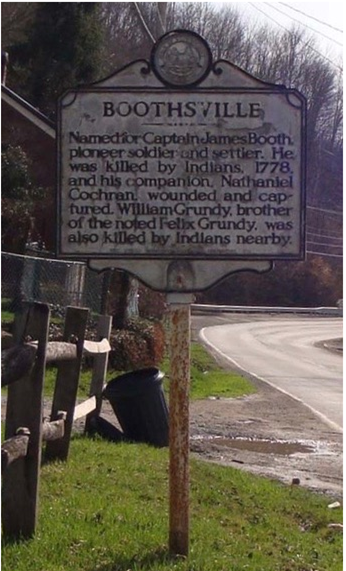 Jane and Thomas Stump took possession of the 200 acre home plantation of Robert Booth where two more generations of Thomas Stumps lived until 1821, when the last Thomas Stump (IV) died and the land divided among his siblings[24]. As early as 1761, a ferry known as Payne’s Ferry operated on the Potomac near the back side of the Thomas Stump Plantation. Thomas, husband of Jane was appointed with others to view a new road from the Potomac River crossing at Stumps Landing to Leesburg[25]. Flayle Payne (Pain), Sr. had settled a part of Maryland across the Potomac River from Stumps Landing near current day Knoxville, MD[26], and his sons Flayle, Jr. and John Payne operated a Ferry there[27].
Jane and Thomas Stump took possession of the 200 acre home plantation of Robert Booth where two more generations of Thomas Stumps lived until 1821, when the last Thomas Stump (IV) died and the land divided among his siblings[24]. As early as 1761, a ferry known as Payne’s Ferry operated on the Potomac near the back side of the Thomas Stump Plantation. Thomas, husband of Jane was appointed with others to view a new road from the Potomac River crossing at Stumps Landing to Leesburg[25]. Flayle Payne (Pain), Sr. had settled a part of Maryland across the Potomac River from Stumps Landing near current day Knoxville, MD[26], and his sons Flayle, Jr. and John Payne operated a Ferry there[27].
Wm. McCoy died in 1764 leaving a wife, Ann (Anna) and three children. Ann then married John Stump (possibly Thomas Stump’s brother) and the family moved to Bedford County, Virginia according to a Family Tree Website. How long Alexis and Henrietta Jackson remained living at their home is unknown, but their son Henry Jackson married Elizabeth Stump and they subsequently lived in Ohio[28]. Ann and William Chambers ultimately took possession of the Alexis and Henrietta home and not the home of Wm. McCoy they inherited[29]. This land stayed in the Chambers family until the tract was partitioned for sale to Johannes (John) Wenner in 1814 by the Chambers grandchildren[30].
In 1775, John Booth son of Robert had the original Robert Booth Land Grant resurveyed and found it to contain not 600 but 840 acres of land. Even though Robert Booth’s will divided the land among his heirs, John Booth as eldest son was granted a new Northern Neck Land Grant for the entire 840 acres of land for an unspecified consideration and continued annual fee rent (quitrent) of one shilling for every 50 acres of land[31]. John Booth and his heirs divided and sold five tracts of land he bought from his brother James: 120 acres to David Mull in 1776[32], 107 acres to Christopher Barnhouse in 1813[33], 83 acres to John George in 1820[34], 67 acres owned by James Booth (s/o John) and divided by his heirs after his death in 1821[35], and 3 acres John Booth, Sr. (son of John) sold to John Booth, Jr. (s/o James) in 1821[36]. John Booth died in or about the year 1788[37], leaving a wife Catherine O. Booth and two sons John and James Booth.
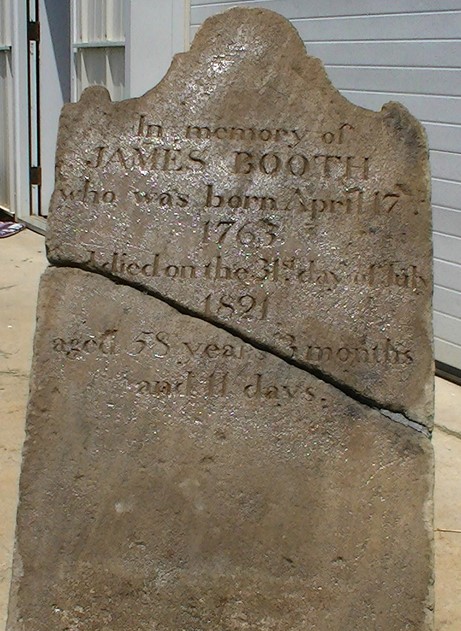 James Booth who died in 1821 left a wife Fanny Booth and eight children Catherine, John, Elenor (sic Eleanor), Aaron, Nancy, Elizabeth, James, and Frances. Figure 3 is James Booth tombstone found several years ago in a wooded lot on a hill some 200 yards West of the Robert Booth Home containing more than a dozen burial sites in what is believed to be a Booth and Stump family graveyard.
James Booth who died in 1821 left a wife Fanny Booth and eight children Catherine, John, Elenor (sic Eleanor), Aaron, Nancy, Elizabeth, James, and Frances. Figure 3 is James Booth tombstone found several years ago in a wooded lot on a hill some 200 yards West of the Robert Booth Home containing more than a dozen burial sites in what is believed to be a Booth and Stump family graveyard.
Figure 3. James Booth (1763-1821) Tombstone.
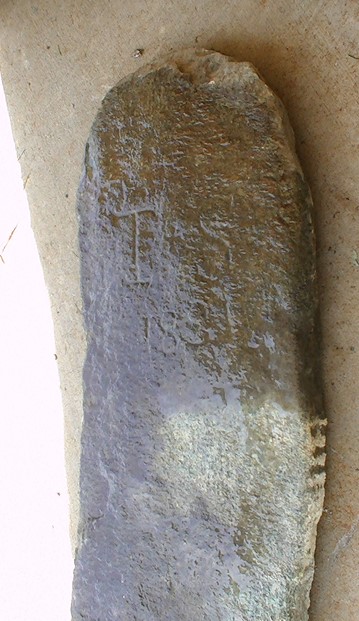 Figure 4 is a photo of the headstone for Thomas Stump (IV), with the lettering “T S 1821.”
Figure 4 is a photo of the headstone for Thomas Stump (IV), with the lettering “T S 1821.”
The division of Robert Booth’s Land Grant as determined by subsequent land sales and parcel divisions is shown in Figure 5. The locations of Robert Booth Plantation Home, Alexis and Henrietta Jackson Place and the McCoy Place are marked at locations believed to be of the period of Robert Booth’s will. The homes and surrounding land have been passed down largely intact as farms through a few local families, mostly surnamed Wenner and Mann. The division of James Booth’s land in 1821 includes the location of his home on a Dower lot for his wife Fanny and is marked as the possible location of Prices Place. The home location for John Booth on his 60 acre tract is unknown.
Figure 5. Division of Robert Booth’s Northern Neck Land Grant as determined by subsequent land Sales and divisions of the 840 acre 1775 resurvey.
Figure 6 is a photo of a bank house believed to be in part that of Robert Booth’s Plantation home. The log portion to the right is typical of the construction for a settler’s house in Colonial Virginia: 16’ x 20’ old forest oak log dwelling with loft on a stone foundation and stone fireplace in the end wall. The top log was notched for a log rafter roof since removed. It is possible that Thomas Stump or his heirs could have added to the house over the 60 odd years they owned it, but the clapboard siding addition to the left and above was probably a more recent addition when the property was purchased by John Mann, Jr[38] who lived and farmed there nearly 70 years. The photo reflects the results of restoration by the most recent owner.
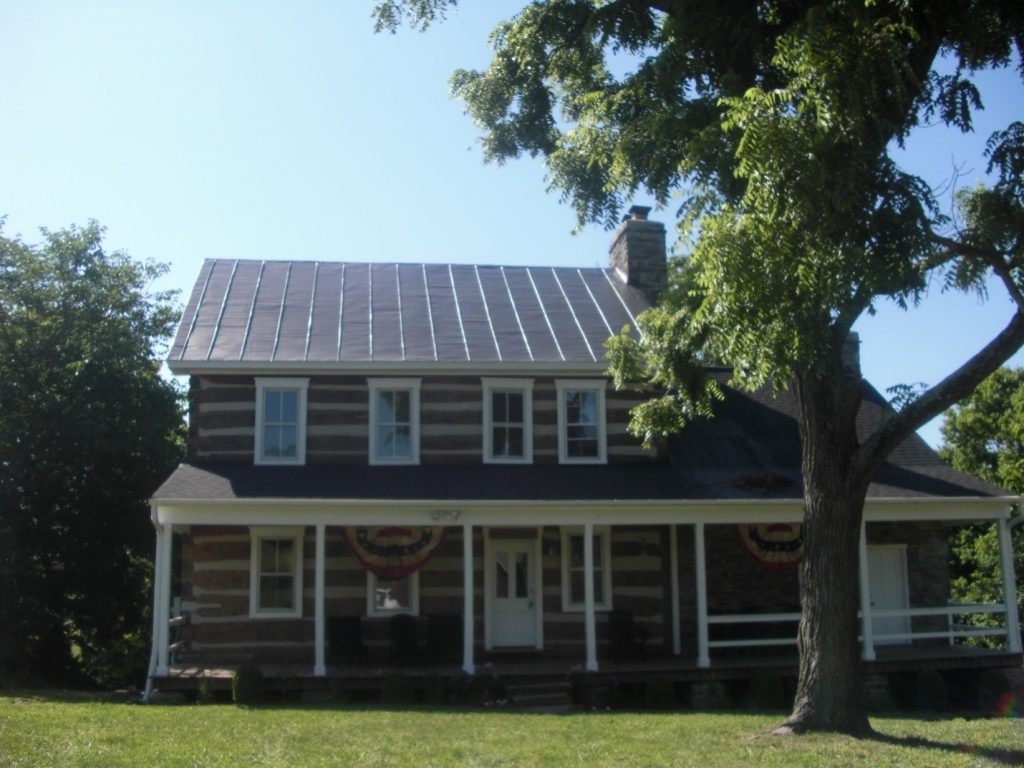 Figure 7 is a photo of a bank house believed to be that of Alexis and Henrietta Jackson, that was seized by the Wm. Chambers family. The large two story log home is built on a stone foundation with a huge cooking fireplace in the basement. An unusual basement feature is a tapered rifle slit in the middle of the west basement wall. The house and surrounding land was purchased by Johannes Wilhelm (John) Wenner from Wm. Chambers heirs over several year period beginning about 1810[39], and it remained a working farm of the Wenner family for nearly 200 years. The photo reflects the results of the current owner’s most recent restorations.
Figure 7 is a photo of a bank house believed to be that of Alexis and Henrietta Jackson, that was seized by the Wm. Chambers family. The large two story log home is built on a stone foundation with a huge cooking fireplace in the basement. An unusual basement feature is a tapered rifle slit in the middle of the west basement wall. The house and surrounding land was purchased by Johannes Wilhelm (John) Wenner from Wm. Chambers heirs over several year period beginning about 1810[39], and it remained a working farm of the Wenner family for nearly 200 years. The photo reflects the results of the current owner’s most recent restorations.
Figure 7. Alexis & Henrietta Jackson Place. (Photo: Harold Gladstone)
Figure 8 is a photo of a bank house believed to be that of Wm. McCoy. The log portion on the right is similar in construction to the house in Figure 6 with a substantial stone structure on the left added at a later date. This house and surrounding farm land was known locally as the “Moore Farm” who owned it for nearly 30 years and probably added the stone extension. This house is the place that John Moore operated a distillery[40]. John Wenner purchased this farm for his three sons in 1834[41], and the home and most of the farm has remained in the possession his descendants today. The photo was taken some years ago after the current owner completed substantial restoration of the property. (Photo: Bobby Wenner)
Notes:
[1] Northern Neck Land Grant E-20A 17,507 Ac. to William Fairfax 10 Apr 1736.
[2] Northern Neck Land Grant C-188 600 Ac. to Robert Booth 7 Jul 1731.
[3] Prince Georges County, MD Piscataway Parish 1692-1726 Vestry Minutes and Parish Record list his marriage to Sarah Filmore without date and birth of first child John in 1718 and second child Jane in 1720, pg. 241.
[4] Cavaliers and Pioneers, Abstracts of Virginia Land Patients and Grants, Nugent, 1934.
[5] Piscataway Parish 1692-1726 Register, pg. 241. Based on the birth of his first child in 1718.
[6] Loudoun County Will Book A pg. 24, Robert Booth’s Will of 20 Sep 1759.
[7] Cavaliers and Pioneers, Nugent 1934.
[8] Robert Booth’s Will Examined 19 Mar 1760, LCWB A pg. 24.
[9] Robert Booth’s Inventory Examined 12 Aug 1760, LCWB A pg. 28.
[10] Piscataway Parish 1692-1726 Vestry Minutes and Parish Record pg. 241.
[11] Prince Georges County Will Book Liber 18 Folio 59, Thomas Stump’s Will 10 May 1723.
[12] Robert Booth Will 20 Sep 1759, LCWB A pg. 24.
[13] ibid
[14] Northern Neck Land Grant C-188, 7 Jul 1731.
[15] James Thomas, Prince William County Surveyor, Robert Booth 600 acre Northern Neck Land Survey, 6 April 1731.
[16] Virginia Northern Neck Land Grants 1742-1775, Vol. II by Gertrude E Gray. P-330, John Booth of Loudoun County set forth there is surplus in 600 Ac. granted Robert Booth 7 July 1731 and on decease of Robert Booth became property of said John as son and heir at law of Robert. Resurvey by John Hough shows 840 Ac (240 Ac surplus) Deed to John Booth. On Potomack R., Dutchmans Run 7 Mar 1775.
[17] Northern Neck Land Grant P-330, Resurvey 840 ac. by John Hough to John Booth 7 Mar 1775.
[18] Robert Booth Will LCDB A pg. 24, 1759.
[19] ibid
[20] Loudoun County, Virginia Tithables 1758-1786 Vol. I, pg. 3, by Marty Hiatt & Craig Roberts Scott
[21] James Booth, Capt. 26 Jun 1777 Deposition, Monongahela County V., Capt. James Booth, appeared before James Chew, one of Justices for the said County, and made oath that to the best of his remembrance it was sometime in May in the Year One Thousand Seven Hundred and Sixty Eight that he first improved his land where he now lives, lying, in the forks of the Monongahela River, and on a creek known by the name of Booths Creek, which empties into the west fork of the said river, and that he believes he was the first settler or improver of land in said forks, sworn to this 26th day of June 1777.
[22] Loudoun County Chancery Court Case Booth vs. Booth M1892 1836, where the plaintiff John Booth of Indiana charged that his father James Booth was deprived of his inheritance from Robert Booth, and John Booth of Virginia replied among other things that his grandfather John Booth son of Robert had purchased the land of his brother James.
[23] Magazine of Virginia Genealogy, Vol. 7, No. 4, pg. 289-294. John Boothe of Indiana v. John Boothe of Loudoun County Chancery Court Case M1892, transcribed by Marty Hiatt.
[24]Stump, Thomas Div. 1821, Loudoun County Deed Book 3E, pg.439, 200 acre Stump land was divided between Thomas Stump’s (IV) sister Sarah and brother Joseph Stump after his death.
[25] Loudoun County Order Book A pg. 483.
[26] Prince Georges County Patented Certificate 1594, 1-2 Pains (sic Payne’s) Delight 100 acres to John Abington surveyed 2 Nov 1730.
[27] Craig H. Trout Peacher’s Mill Working Papers pg.5, 13 Jun 2010 states the ferry served as an important early Potomac River crossing.
[28] Loudoun County Deed Book 2X pg. 143. Jackson to Booth indenture for interest in 60 acres of land devised to John Booth made 7 Sep 1818 in Guernsey County, Ohio.
[29] Loudoun County Chancery Court Case Mann vs. Moore M1774, 1825. In a land dispute regarding the land inherited by Robert Chambers, a deposition by William Chambers (William and Ann Chambers grandson) testified the land taken by William and Ann Chambers was not the McCoy tract but a residence some 150 yards away (believed to be the Jackson Home).
[30]Wenner vs. Stump Loudoun County Deed Book 2R, pg. 313. John Wenner, a purchaser of Chambers land brought suit against Stump heirs to partition the 400 acres of land inherited by the Chambers and Stumps families 12 Apr 1814.
[31] Northern Neck Land Grant P-330 840 Ac. to John Booth 7 Mar 1775.
[32] Booth to Mull Loudoun County Deed Book L, pg. 97. John Booth & Catherine his wife 120 Ac. to David Mull tract of land East of Short Hill & next to Dutchman Run 20 Feb. 1776.
[33] Booth to Barnhouse Loudoun County Deed Book 2R pg. 203. Indenture made 15 Sep 1813 between Catherine Booth, John Booth & James Booth of Loudoun Co. to Christopher Barnhouse of Loudoun Co a Tract of Land being an inclusive patient to John Booth bearing date 7 March 1775 (840 ac.) containing one hundred and seven acres.
[34] Booth to George Loudoun County Deed Book 3B pg. 333, 15 Nov 1820. Indenture made 28 Jun 1820 between John Booth Jr. of Virginia (great grandson of Robert) and John Booth of Indiana (grandson of Robert Booth) an 83 acre tract of land devised to James Booth, father of John Booth Jr. of Virginia.
[35] James Booth Division Loudoun County Deed Book 3E pg. 173, 17 Feb 1822. Division of James Booth’s land in 9 parcels including a home on parcel 3 (the Dower lot) containing a total of 58 acres.
[36] Booth to Booth Loudoun County Deed Book 3C, pg.126, 8 Mar 1821. John Booth, Sr. (son of John) to John Booth, Jr. (son of James) 3 acres, part of land John Booth purchased from his brother James.
[37] Loudoun County Chancery Court Case Booth vs. Stump M7218, 16 Aug 1815. A land partition case dividing the 60 acres John Booth inherited from his father Robert stated “…that the said John Booth the Devisee named in the clause aforesaid of the said Will died on or about the year 1788…”.
[38] Mann to Mann Loudoun County Deed Book 3V pg. 249. Two acres from John Mann, Sr. to John Mann, Jr., 5 Mar 1830.
[39] Chambers to Wenner Loudoun County Deed Book 2M pg. 107. James Chambers rights to 230 acres of undivided land inherited from Wm. Chambers, 10 Sep 1810.
[40] John Moore Affidavit of 10 Feb 1823 from Sanders vs. Booth Loudoun County Chancery Court case M1915, regarding a challenge to John Booth, Sr. will, “ Despondent (John Moore) being first sworn says that he lives about from ¼ to ½ mile from the place where John Booth the younger lives and John Booth the elder died, that he keeps a distillery and sells there from whiskey, …”
[41] Moore to Wenner Loudoun County Deed Book 4B pg. 463. 107 ½ acres from John Moore to William, Emanuel, and Jacob Wenner, 6 Feb 1834.

